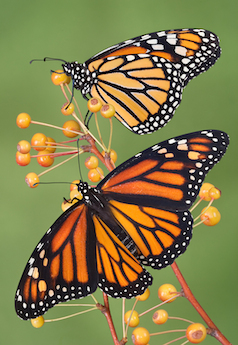By Maria Benevento
Every winter, by means not fully understood, each monarch butterfly east of the Rocky Mountains makes a journey of up to 3,000 miles to one of a few locations in Mexico. The monarchs congregate so densely that they cover the trees, creating what many consider to be one of the most beautiful scenes in nature. Monarch Watch, a website directed by Chip Taylor of the University of Kansas, reports that at the population’s peak in 1997, an estimated one billion monarchs congregated within just 20.97 hectares at overwintering sites. By 2014, monarch numbers had plummeted by 97%.Today, many experts fear we are at risk of entirely losing this population of monarchs.
Several factors have contributed to the monarchs’ decline, but the most important is habitat loss. Taylor estimates that monarchs have lost 167 million acres of breeding habitat since 1996. About 1 million acres become unsuitable for monarchs due to development each year, but changing agricultural practices have caused much of the habitat loss. Americans have added 30.9 million more acres of corn and soybeans since 1996, largely due to government support for ethanol production.
By itself, says Taylor, this may not have harmed monarch butterflies. Milkweed, monarch caterpillars’ only food source, can grow alongside corn. However, the development of genetically modified “Roundup Ready” corn allowed farmers to use herbicides on their fields, killing everything in the field except their crop. As expanding cornfields become deserts for everything except corn, monarch caterpillars are quickly losing their food supply.
The butterflies’ habit of gathering so densely also makes them extremely vulnerable to severe weather in their overwintering sites; according to monarch expert Lincoln Brower of Sweet Briar College, one storm can kill as much as 75% of the population. In the past, the huge numbers of butterflies made the species resilient. Today, deforestation exposes more monarchs to the elements, and the much smaller population would have a harder time recovering from a storm.
Monarchs are such a well-known and previously common species that the idea of their extinction could seem ridiculous. In a presentation for Omaha’s Phi Beta Kappa alumni association, Theodore E. Burk, a biology professor at Creighton University, compared them to Passenger Pigeons. The birds were so numerous that it “seemed inconceivable that they could go extinct,” yet now we resent our ancestors for their lack of foresight.
“We’ve got to save one of the coolest things in nature,” Burk added. “You could say the monarch migration is one of the greatest marvels of God’s creation or one of the most beautiful results of evolution. Losing the monarchs would leave an impoverished world…Our descendants would probably not forgive us if we were the ones who through selfishness and shortsightedness let them die out.”
Many groups have been trying to help save the monarchs. Monarch Watch provides information about monarchs and instructions for planting milkweed and nectar flowers, raising butterflies, and becoming involved with research projects. The U.S. Fish and Wildlife Service decided in December that the case for putting monarchs on the endangered species list has enough merit to warrant a one-year study. If they are placed on the list, monarchs will receive additional funding, research, and protection. Monarch Joint Venture, the National Wildlife Federation, and the Xerces society also provide resources for monarch conservation. Even Monsanto, the company responsible for the genetically engineered crops that have unexpectedly proven so detrimental to the monarchs, has offered 4 million dollars in funding.
It is not likely that farmers will reconvert their land to prairie or stop using Roundup Ready crops, says Burk. If the butterflies are to survive, it will require a widespread effort by schools, parks, and private citizens to plant milkweed and wildflowers for monarch caterpillars and adults. Burk also suggests policy changes such as ending mowing along highways and removing milkweed from the list of prohibited plants for neighborhood “weed ordinances.” “We all have to do what we can,” he urges. “I can’t plant enough milkweed to make a difference, but I can make the public aware. We need a collective effort of everyone doing what they can…hopefully we can get enough habitat back to stop the species from going extinct.”
Maria Benevento is a senior at Creighton University majoring in Theology and American Studies. Creighton University is home to the Beta of Nebraska Chapter of Phi Beta Kappa.




